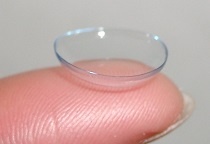Last year I asked the question, Will noninvasive glucose monitoring end in tears? That article described the measurement of blood glucose without needles, without pain and without injury as the holy grail of glucose monitoring in diabetes. The hype that formed after Google’s announcement of their smart contact lens project raised huge expectations that a noninvasive solution was finally realistic and near. Since the initial project announcement in 2014, information on its progress has been scarce and a delay in clinical testing of the contact lens has fed speculations that the whole project will end in bitter disappointment. In this article, an update of the status of the smart contact lens project is given and new smart ideas for noninvasive glucose monitoring are discussed.
Smart contact lens projects
The update on Google’s smart contact lens project can be short: Verily and Alcon who took over this project have not disclosed any new information in the past year. The information on Verily’s website remains unchanged and lists a glucose-sensing lens along with an accommodating contact lens for farsightedness as part of the work in the smart contact lens project. The project may be moving forward, but dates for clinical testing of the technology are still unknown.
In the meantime, other smart contact lens projects have picked up momentum and some groups have published their research. A group of South Korean researchers have managed to integrate glucose sensing technology in soft lenses that are comfortable to wear. Despite the waned enthusiasm for contact lens glucose sensing, this new research has again created headlines full of expectation. Under laboratory conditions, the integrated sensor demonstrates good glucose sensing capabilities with high sensitivity, low response time, negligible measurement drift over 48 hours and negligible interference of substances other than glucose. The accuracy of the sensor under in vivo conditions was not (yet) evaluated.
Without a doubt I believe that miniature sensing technology can be produced that accurately measures glucose in minute quantities in tear fluid. However, how sophisticated the sensing technology may be, a prerequisite for any working smart contact lens is that the glucose concentration in tear fluid can be used as a reliable indicator for the actual glucose concentration in blood. In contrast to blood and interstitial fluid no evidence exists for a function of glucose in tear fluid, and it seems that it’s not in the body’s interest to actively control the glucose content in tear fluid. And where blood and interstitial fluid are well protected in a closed environment, tear fluid is constantly exposed to ambient factors such as temperature, humidity and wind. Changes in these ambient factors will affect the tear fluid layer of the eye and consequently its glucose content. Combined with other stimuli (physical, chemical and emotional) that affect tear glucose content, the resulting unphysiological changes probably present the largest hurdle in the development of a smart contact lens.
Other smart contact lens projects, such as a collaboration between EPGLMed and Apple, seem to shy away from the tear glucose sensing issues and are developing smart eye wearables for use in augmented reality applications without promise of medical functionality.
Other smart ideas
Smart contact lenses are not the only attempts to develop a noninvasive glucose monitor. A wide array of measurement techniques, including spectroscopic, optical rotation, fluorescence and electrical impedance measurements have been developed to directly or indirectly track glucose levels through the surface of skin, in the eye, in breath and in bodily fluids other than tear fluid that are readily accessible such as sweat and saliva. An accurate estimation of blood glucose levels however has proven to be a challenge for any noninvasive technology. For this reason, a first approach for a working sensor may be to give patients a rough indication of the glucose level (low, in control, high; also referred to as traffic light system) or of glucose dynamics (rapidly falling, falling, stable, rising, rapidly rising), rather than providing a single glucose value. One such system, a wearable pod that can be worn on the upper arm using an elastic band, is being developed by a Swiss company called Biovotion. It uses an array of sensors to estimate glucose trends. In a recently published study of this technology in 20 patients with type 1 diabetes, the noninvasive sensor performance was tested using venous blood glucose measurements as reference. Using the five categories of glucose dynamics above, the same glucose trend was found for the noninvasive sensor and a blood-based reference in 49.3% of all measurements . For the remaining 51.7% measurements that did not provide equal outcome, the difference was 1 category in 41.6% and 2 or more categories in 9.1% of all measurements. These results show that noninvasive tracking of blood glucose levels does seem feasible, but further progress is needed to make the performance more robust.
Miniaturisation of wearable technology is a goal for many noninvasive sensor researchers. A development of UC San Diego Jacobs School of Engineering called a “tattoo sensor” provides an idea of the smart technology we may see in the future. The sensor is applied like a temporary sticker or kid’s tattoo by applying it on the skin, dabbing the tattoo with water and removing the back paper. The glucose sampling principle is similar to that of the only ever commercial noninvasive sensor, the GlucoWatch® G2 Biographer (Cygnus, Redwood City, CA). This principle, the reverse iontophoresis method uses a low electric current actively pulling glucose through the skin. A risk of this method is local skin irritation and the ongoing clinical trial in 50 patients with type 1 diabetes is apart from sensor accuracy closely evaluating any discomfort of the measurement. The current prototype of the tattoo sensor performs one single measurement, future plans include a sensor that can stay on the skin and provide continuous / multiple measurements.
Summary
More than four years after the announcement of Google’s smart contact lens program, not much is known about the current status of the program. Despite the waned enthusiasm for contact lens glucose sensing, noninvasive glucose monitoring is a highly desired technology and research groups remain active in this field with innovative and smart ideas.





